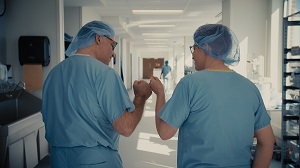Henry Ford Doctor Performs First Transcaval Heart Procedure in Europe
DETROIT – A renowned Henry Ford Hospital cardiologist helped perform the first successful transcaval valve replacement in Europe on Dec. 1, sharing his expertise on a pioneering way to access the heart.
Henry Ford was the first hospital in the world to perform the unique procedure, which accesses the heart for valve replacement by temporarily connecting major blood vessels in the abdomen. Henry Ford cardiologist Adam Greenbaum, M.D., co-director of the Henry Ford Center for Structural Heart Disease, who also taught the technique to seven other centers in the United States, was asked to share the technique at the German Heart Centre Munich with Dr. Markus Kasel. They performed the technique for a middle-aged German man, who is recovering nicely, Greenbaum reports.
“We are pleased that the advanced cardiology procedures we perform at Henry Ford can help patients both here and around the world,” says Dr. Greenbaum. Henry Ford cardiologists estimate the procedure could help 25,000 to 50,000 patients in the United States annually, when scar tissue, small arteries or other medical issues prevent cardiologists from using traditional access to the heart. Now, the option will be available to patients in Europe, too, Greenbaum said.
Henry Ford Hospital cardiologists performed the health system’s first transcaval procedure on July 3, 2013 in Detroit. Traditional valve replacement was not medically viable for an 80-year-old Northern Michigan great-grandmother, who’s alive and well today.
During transcaval valve replacement, a wire is guided into a leg and up through the femoral vein. Cardiologists then poke through the vein and a parallel artery in the abdomen. By gradual dilation, the openings are widened, and a catheter is placed as a bridge between the two. Doctors can then use a smaller catheter to move through the vein, across the bridge and up through the artery into the heart to implant a new artificial aortic heart valve. After the valve is placed, the catheter bridge is removed and a plug closes the holes in the artery and the vein so the two major blood vessels can function as normal.
The technique was perfected by Greenbaum, Henry Ford cardiologist William O’Neill, M.D., and Robert Lederman, M.D., an interventional cardiologist at the National Heart, Lung, and Blood Institute, who developed the transcaval technique in a research setting. Dr. Greenbaum led the team who performed the first procedure at Henry Ford. He worked alongside Dr. O’Neill and Gaetano Paone, M.D., Division Head of Cardiac Surgery at Henry Ford Hospital's Edith and Benson Ford Heart & Vascular Institute.
Approximately 5 million people in the U.S. are diagnosed with heart valve disease annually. With an aging population that is often too frail for open-heart surgery, more than 20,000 Americans die of the disease each year, according to the American Heart Association.
For more information on heart valve replacement, or an appointment at Henry Ford Hospital, call (313) 916-1878 or visit the Center for Structural Heart Disease.
.svg?iar=0&hash=F6049510E33E4E6D8196C26CCC0A64A4)

/hfh-logo-main--white.svg?iar=0&hash=ED491CBFADFB7670FAE94559C98D7798)









